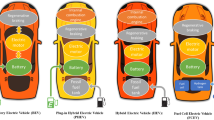Abstract
A new model of a quantum heat engine (QHE) cycle is established, in which the working substance consists of an interacting electrons system. One of our purposes is to test the validity of the second law of thermodynamics by this model, which is more general than the spin-1/2 antiferromagnetic Heisenberg model since it would recover the spin model when the on-site Coulomb interaction U is strong enough. On the basis of quantum mechanics and the first law of thermodynamics, we show no violation of the second law of thermodynamics during the cycle. We further study the performance characteristics of the cycle by investigating in detail the optimal relations of efficiency and dimensionless power output. We find that the efficiency of our engine can be expressed as η = 1 − t 22 /t 12 in the large-U limit, which is valid even for a four sites QHE.
Similar content being viewed by others
References
Scovil H E D, Schulz-DuBois E O. Three-level masers as heat engines. Phys Rev Lett, 1959, 2: 262–263
Geusic J E, Schulz-DuBois E O, Scovil H E D. Quantum equivalent of the Carnot cycle. Phys Rev, 1967, 156: 343–351
Geva E, Kosloff R. A quantum-mechanical heat engine operating in finite time. A model consisting of spin-1/2 systems as working fluid. J Chem Phys, 1992, 96(4): 3054–3067
Allahverdyan A E, Nieuwenhuizen T M. Extraction of work from a single thermal bath in the quantum regime. Phys Rev Lett, 2000, 85: 1799–1802; Allahverdyan A E, Nieuwenhuizen T M. Breakdown of the Landauer bound for information erasure in the quantum regime. Phys Rev E, 2001, 64: 056117–056125; Allahverdyan A E, Nieuwenhuizen T M. A mathematical theorem as the basis for the second law: Thomson’s formulation applied to equilibrium. Physica A, 2002, 305: 542–552; Allahverdyan A E, Nieuwenhuizen Th M. Statistical thermodynamics of quantum Brownian motion: Construction of perpetuum mobile of the second kind. Phys Rev E, 2002, 66: 036102–036153
Capek V. Zeroth and second laws of thermodynamics simultaneously questioned in the quantum microworld. Eur Phys J B, 2002, 25: 101–113
Tasaki H. Comment on “Extraction of work from a single thermal bath in the quantum regime”. ArXiv: cond-mat/0011099v3
Scully M O. Quantum afterburner: Improving the efficiency of an ideal heat engine. Phys Rev Lett, 2002, 88: 050602–050605
Kieu T D. The second law, Maxwell’s demon, and work derivable from quantum heat engines. Phys Rev Lett, 2004, 93: 140403–140406
Quan H T, Wang Y D, Liu Y X, et al. Maxwell’s demon assisted thermodynamic cycle in superconducting quantum circuits. Phys Rev Lett, 2006, 97: 180402–180405
Quan H T, Liu Y X, Sun C P, et al. Quantum thermodynamic cycles and quantum heat engines. Phys Rev E, 2007, 76: 031105–031122
Kieu T D. Quantum heat engines, the second law and Maxwell’s daemon. Eur J Phys D, 2006, 39: 115–128
Bender C M, Brody D C, Meister B K. Quantum mechanical Carnot engine. J Phys A, 2000, 33: 4427–4436
Opatrny T, Scully M O. Enhancing otto-mobile efficiency via addition of a quantum Carnot cycle. Fortschr Physik, 2002, 50: 657–663
Scully M O, Zubairy M S, Agarwal G S, et al. Extracting work from a single heat bath via vanishing quantum coherence. Science, 2003, 299: 862–864
Quan H T, Zhang P, Sun C P. Quantum-classical transition of photon-Carnot engine induced by quantum decoherence. Phys Rev E, 2006, 73: 036122–036127
Bender C M, Brody D C, Meister B K. Entropy and temperature of a quantum Carnot engine. Proc R Soc Lond A, 2002, 458: 1519–1526
Tonner F, Mahler G. Quantum limit of the Carnot engine. Fortschr Physik, 2006, 54: 939–956
Wu F, Chen L, Sun F, et al. Performance of an irreversible quantum Carnot engine with spin-1/2. J Chem Phys, 2006, 124(21): 214702
Wang J, He J, Xin Y. Performance analysis of a spin quantum heat engine cycle with internal friction. Phys Scr, 2007, 75(2): 227–234
Liu X, Chen L, Wu F, et al. Ecological optimization of an irreversible quantum Carnot heat engine with spin-1/2 systems. Phys Scr, 2010, 81(2): 025003
Liu X, Chen L, Wu F, et al. Ecological optimization of an irreversible harmonic oscillators Carnot heat engine. Sci China Ser G-Phys Mech Astron, 2009, 52(12): 1976–1988
Sisman A, Saygin H. The improvement effect of quantum degeneracy on the work from a Carnot cycle. Appl Energy, 2001, 68(4): 367–376
Wu F, Chen L, Li D, et al. Thermodynamic performance on a thermoacoustic engine micro-cycle under the condition of weak gas degeneracy. Appl Energy, 2009, 87(7–8): 1119–1123
He J, He X, Tang W. The performance characteristics of an irreversible quantum Otto harmonic refrigeration cycle. Sci China Ser G-Phys Mech Astron, 2009, 52(9): 1317–1323
Feldmann T, Kosloft R. Performance of discrete heat engines and heat pumps in finite time. Phys Rev E, 2000, 61: 4774–4790
Quan H T, Zhang P, Sun C P. Quantum heat engine with multilevel quantum systems. Phys Rev E, 2005, 72: 056110–056119
Zhang T, Liu W T, Chen P X, et al. Four-level entangled quantum heat engines. Phys Rev A, 2007, 75: 062102–062107
Feldmann T, Geva E, Kosloff R, et al. Heat engines in finite time governed by master equations. Am J Phys, 1996, 64: 485–492
Anderson P W. When the electron falls apart. Phys Tod, 1997, 50(10): 42–49
Hubbard J. Electron correlations in narrow energy bands. Proc R Soc London Ser A, 1963, 276: 238–257; Gutzwiller M C. Effect of correlation on the ferromagnetism of transition metals. Phys Rev Lett, 1963, 10: 159–162
Kittel C. Introduction to Solid State Physics. 7th ed. New York: Wiley, 1996
Author information
Authors and Affiliations
Corresponding author
Rights and permissions
About this article
Cite this article
Wang, H., Pan, H. & Wang, R. Quantum heat engine cycle working with a strongly correlated electron system. Sci. China Phys. Mech. Astron. 55, 792–797 (2012). https://doi.org/10.1007/s11433-012-4678-9
Received:
Accepted:
Published:
Issue Date:
DOI: https://doi.org/10.1007/s11433-012-4678-9




